Synthesis and Electrochemical Performance of Mesoporous NiMn2O4 Nanoparticles as an Anode for Lithium-Ion Battery
Abstract
:1. Introduction
2. Experimental Procedure
2.1. Materials and Methods
2.2. Material Characterization
2.3. Electrode Fabrication
2.4. Electrochemical Measurement
3. Result and Discussion
3.1. Material Analysis
3.2. Electrochemical Performance
4. Conclusions
Supplementary Materials
Author Contributions
Funding
Acknowledgments
Conflicts of Interest
References
- Xu, B.; Qian, D.; Wang, Z.; Meng, Y.S. Recent progress in cathode materials research for advanced lithium ion batteries. Mater. Sci. Eng. R 2012, 73, 51–65. [Google Scholar] [CrossRef]
- Yuan, H.; Wang, X.; Wu, Q.; Shu, H.; Yang, X. Effects of Ni and Mn doping on physicochemical and electrochemical performances of LiFePO4/C. J. Alloys Compd. 2016, 675, 187–194. [Google Scholar] [CrossRef] [Green Version]
- Hu, R.; Zhang, H.; Bu, Y.; Zhang, H.; Zhao, B.; Yang, C. Porous Co3O4 nano fibers surface-modified by reduced graphene oxide as a durable, high-rate anode for lithium ion battery. Electrochim. Acta 2017. [Google Scholar] [CrossRef]
- Kulova, T.L.; Kreshchenova, Y.M.; Kuzmina, A.A.; Skundin, A.M.; Stenina, I.A.; Yaroslavtsev, A.B. New high capacity anode materials based on gallium doped lithium titanate. Mendeleev Commun. 2016, 26, 238–239. [Google Scholar] [CrossRef]
- Li, F.; Chen, P.; Wu, H.; Zhang, Y. Cooperative enhancement of electrochemical properties in double carbon decorated Li4Ti5O12/C composite as anode for Li-ion batteries. J. Alloys Compd. 2015, 633, 443–447. [Google Scholar] [CrossRef]
- Pathak, R.; Gurung, A.; Elbohy, H.; Chen, K.; Reza, K.; Bahrami, B.; Mabrouk, S.; Ghimire, R.; Hummel, M.; Gu, Z.; et al. Self-Recovery in Li-Metal Hybrid Lithium-Ion Battery via WO3 Reduction. Nanoscale 2018, 10, 15956–15966. [Google Scholar] [CrossRef] [PubMed]
- Goriparti, S.; Miele, E.; Angelis, F.D.; Fabrizio, E.D.; Zaccaria, R.P.; Capiglia, C. Review on recent progress of nano structured anode materials for Li-ion batteries. J. Power Sources 2014, 257, 421–443. [Google Scholar] [CrossRef] [Green Version]
- Cao, K.; Jin, T.; Yang, L.; Jiao, L. Recent progress on conversion reaction metal oxide anodes for Li ion batteries. Mater. Chem. Front. 2017. [Google Scholar] [CrossRef]
- Ouyang, Y.; Feng, Y.; Zhang, H.; Liu, L.; Wang, Y. Designing Sandwiched and Crystallized NiMn2O4/C Arrays for Enhanced Sustainable Electrochemical Energy Storage. ACS Sustain. Chem. Eng. 2017, 5, 196–205. [Google Scholar] [CrossRef]
- Bhagwan, J.; Rani, S.; Sivasankaran, V.; Yadav, K.; Sharma, Y. Improved energy storage, magnetic and electrical properties of aligned, mesoporous and high aspect ratio nanofibers of spinel-NiMn2O4. Appl. Surf. Sci. 2017. [Google Scholar] [CrossRef]
- Yuvaraj, S.; Selvan, R.K.; Lee, Y.S. An overview of AB2O4- and A2BO4-structured negative electrodes for advanced Li-ion batteries. RSC Adv. 2016. [Google Scholar] [CrossRef]
- Chitra, S.; Kalyani, P.; Mohan, T.; Gangadharan, R.; Yebka, B.; Castro-Garcia, S.; Massot, M.; Julien, C.; Eddrief, M. Characterization and Electrochemical Studies of LiMn2O4 Cathode Materials Prepared by Combustion Method. J. Electroceram. 1999, 3, 433–441. [Google Scholar] [CrossRef]
- Rajoba, S.J.; Jadhav, L.D.; Patil, P.S.; Tyagi, D.K.; Varma, S.; Wani, B.N. Enhancement of Electrical Conductivity of LiFePO4 by Controlled Solution Combustion Synthesis. J. Electron. Mater. 2017, 46, 1683–1691. [Google Scholar] [CrossRef]
- Rajoba, S.J.; Jadhav, L.D.; Kalubarme, R.S.; Patil, P.S.; Varma, S.; Wani, B. Electrochemical performance of LiFePO4/GO composite for Li-ion batteries. Ceram. Int. 2018, 44, 6886–6893. [Google Scholar] [CrossRef]
- Phadatare, M.; Patil, R.; Blomquist, N.; Forsberg, S.; Örtegren, J.; Hummelgård, M.; Meshram, J.; Hernández, G.; Brandell, D.; Leifer, K.; et al. Silicon-Nanographite Aerogel-Based Anodes for High Performance Lithium Ion Batteries. Sci. Rep. 2019, 9, 14621. [Google Scholar] [CrossRef] [Green Version]
- Ray, A.; Roy, A.; Ghosh, M.; Ramos-Ramón, J.A.; Saha, S.; Pal, U.; Bhattacharya, S.K.; Das, S. Study on charge storage mechanism in working electrodes fabricated by sol-gel derived spinel NiMn2O4 nanoparticles for supercapacitor application. Appl. Surf. Sci. 2019, 463, 513–525. [Google Scholar] [CrossRef]
- Sahoo, S.; Zhang, S.; Shim, J.-J. Porous Ternary High Performance Supercapacitor Electrode Based on Reduced Graphene Oxide, NiMn2O4, and Polyaniline. Electrochim. Acta 2016, 216, 386–396. [Google Scholar] [CrossRef]
- Rajoba, S.J.; Sartale, S.D.; Jadhav, L.D. Investigating functional groups in GO and r-GO through spectroscopic tools and effect on optical properties. Opt. Int. J. Light Electron Opt. 2018, 175, 312–318. [Google Scholar] [CrossRef]
- Zhang, M.; Guoa, S.; Zheng, L.; Zhang, G.; Haoc, Z.; Kang, L.; Liu, Z. Preparation of NiMn2O4 with large specific surface area from an epoxide driven sol gel process and its capacitance. Electrochim. Acta 2013, 87, 546–553. [Google Scholar] [CrossRef]
- Wang, Z.; Zhu, Z.; Zhang, C.; Xu, C.; Chen, C. Facile synthesis of reduced graphene oxide/NiMn2O4 nano rods hybrid materials for high performance super capacitors. Electrochim. Acta. 2017, 230, 438–444. [Google Scholar] [CrossRef]
- Kim, M.R.; Kalla, R.M.N.; Kim, S.; Kim, M.R.; Kim, I. NiMn2O4 nano-sheet decorated hierarchically porous polyaromatic carbon spheres for high performance super capacitors. ChemElectroChem 2017. [Google Scholar] [CrossRef]
- Huang, J.; Wang, W.; Lin, X.; Gu, C.; Liu, J. Three dimensional sandwich structured NiMn2O4/reduced graphene oxide nano composites for highly reversible Li-ion battery anodes. J. Power Sources 2018, 378, 677–684. [Google Scholar] [CrossRef]
- Li, L.; Yao, Q.; Liu, J.; Ye, K.; Liu, B.; Liu, Z.; Yang, H.; Chen, Z.; Duan, J.; Zhang, B. Porous Hollow Super lattice NiMn2O4/NiCo2O4 Meso crystals as a Highly Reversible Anode Material for Lithium Ion Batteries. Front. Chem. 2018, 6, 153. [Google Scholar] [CrossRef] [PubMed]
- Kang, W.; Tang, Y.; Li, W.; Yang, X.; Xue, H.; Yang, Q.; Lee, C. High interfacial storage capability of porousNiMn2O4/C hierarchical tremella-like nanostructures as lithium ion battery anode. Nanoscale 2015, 7, 225–231. [Google Scholar] [CrossRef]
- Ma, Y.; Tai, C.-W.; Younesi, R.; Gustafsson, T.; Lee, J.Y.; Edström, K. Iron Doping in Spinel NiMn2O4: Stabilization of the Meso porous Cubic Phase and Kinetics Activation toward Highly Reversible Li+ Storage. Chem. Mater. 2015. [Google Scholar] [CrossRef]
- Thauer, E.; Ottmann, A.; Schneider, P.; Möller, L.; Deeg, L.; Zeus, R.; Wilhelmi, F.; Schlestein, L.; Neef, C.; Ghunaim, R.; et al. Filled Carbon Nanotubes as Anode Materials for Lithium-Ion Batteries. Molecules 2020, 25, 1064. [Google Scholar] [CrossRef] [PubMed] [Green Version]
- Zhao, S.; Li, H.; Jian, Z.; Xing, Y.; Zhang, S. Selfassembled hierarchical porous NiMn2O4 microspheres as high performance Li-ion battery anodes. RSC Adv. 2018, 8, 41749–41755. [Google Scholar] [CrossRef] [Green Version]
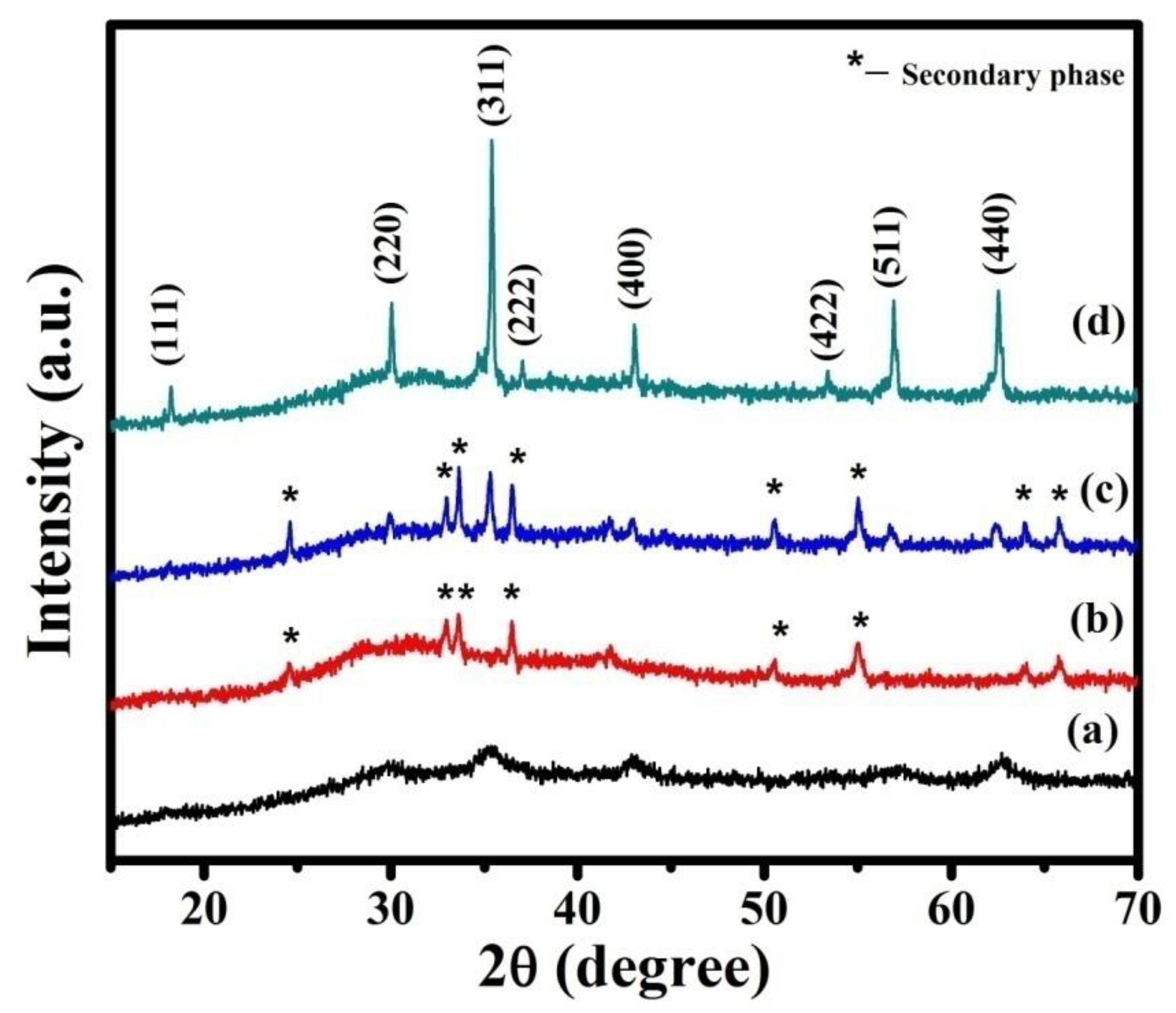
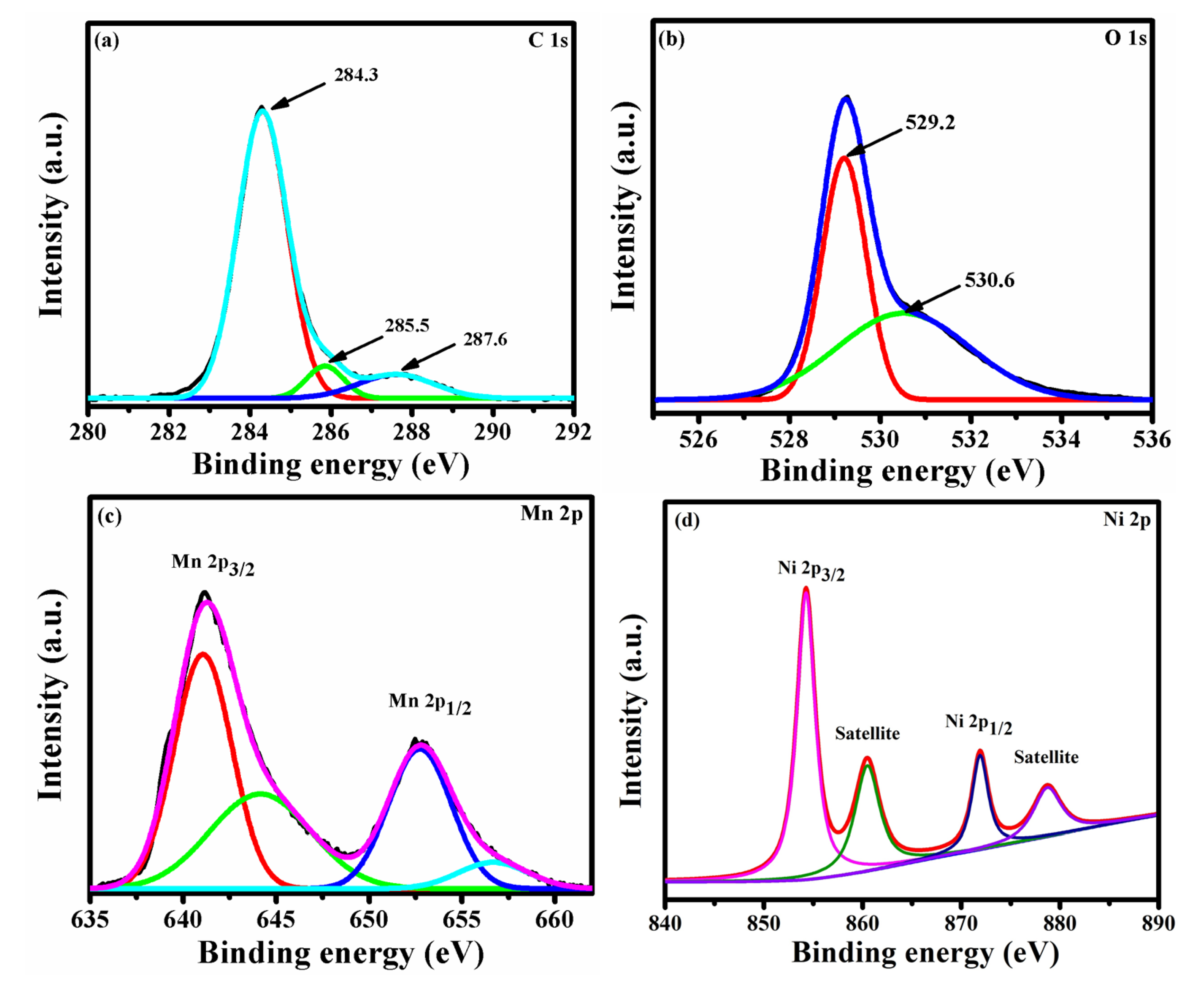
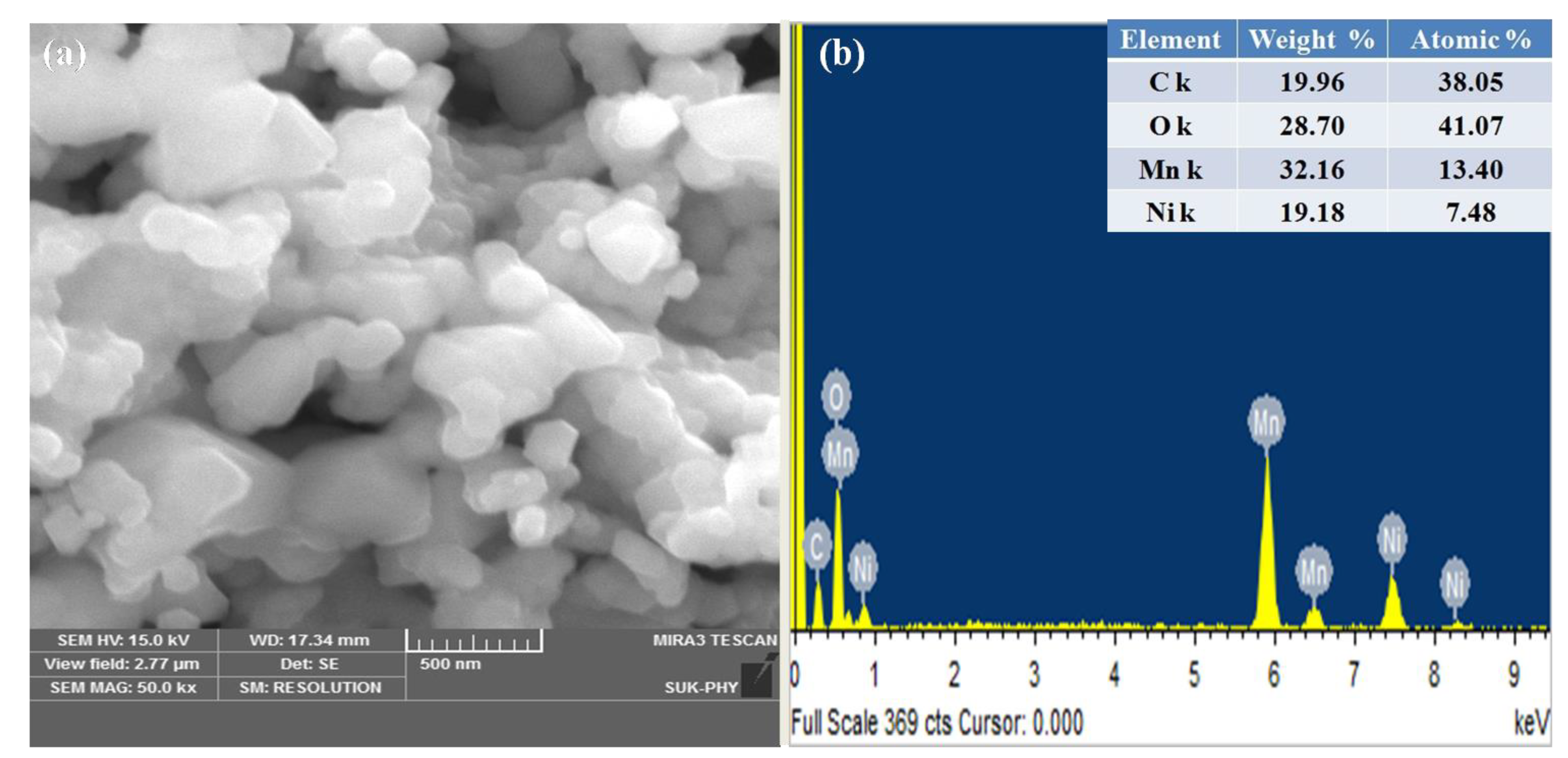
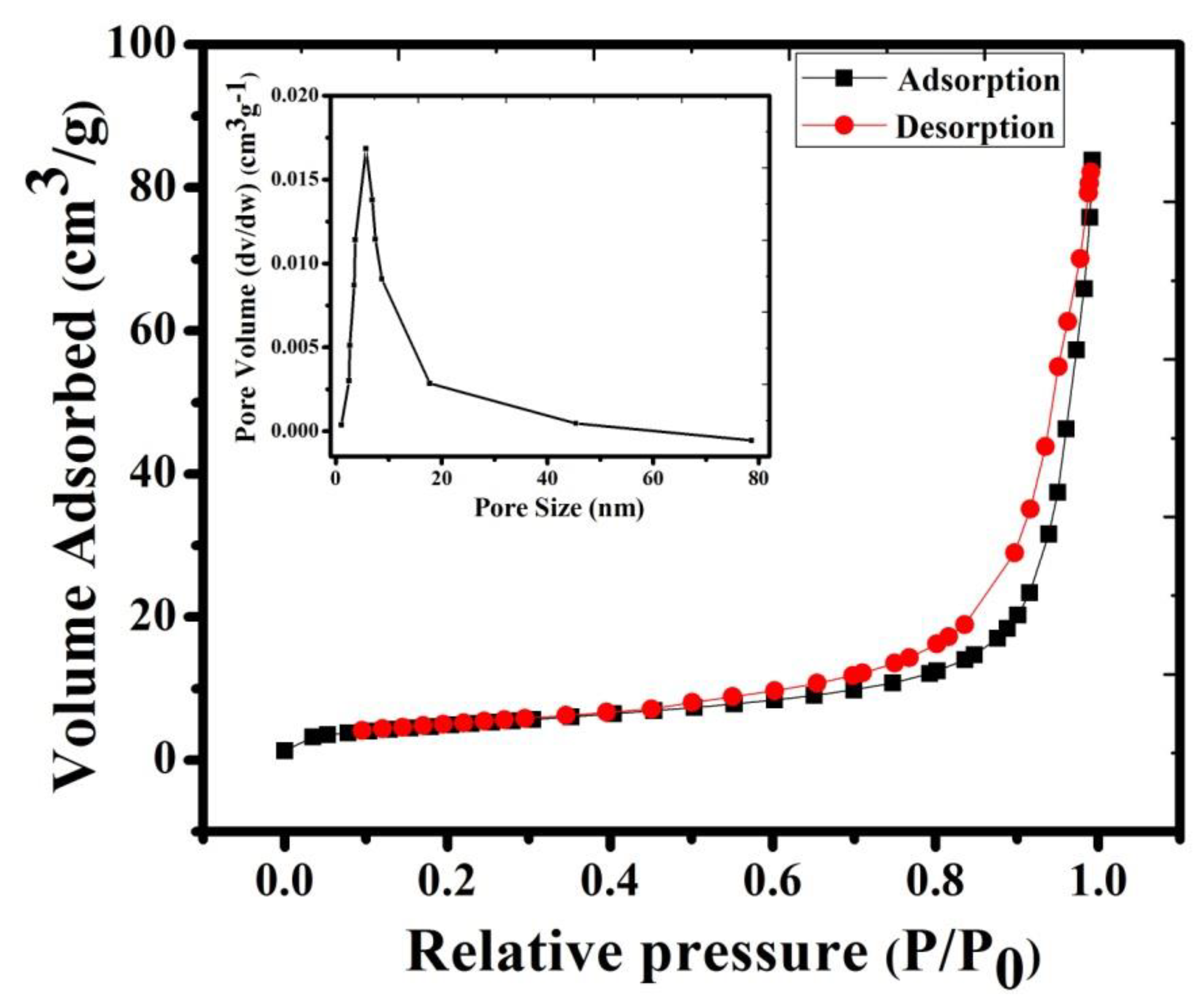
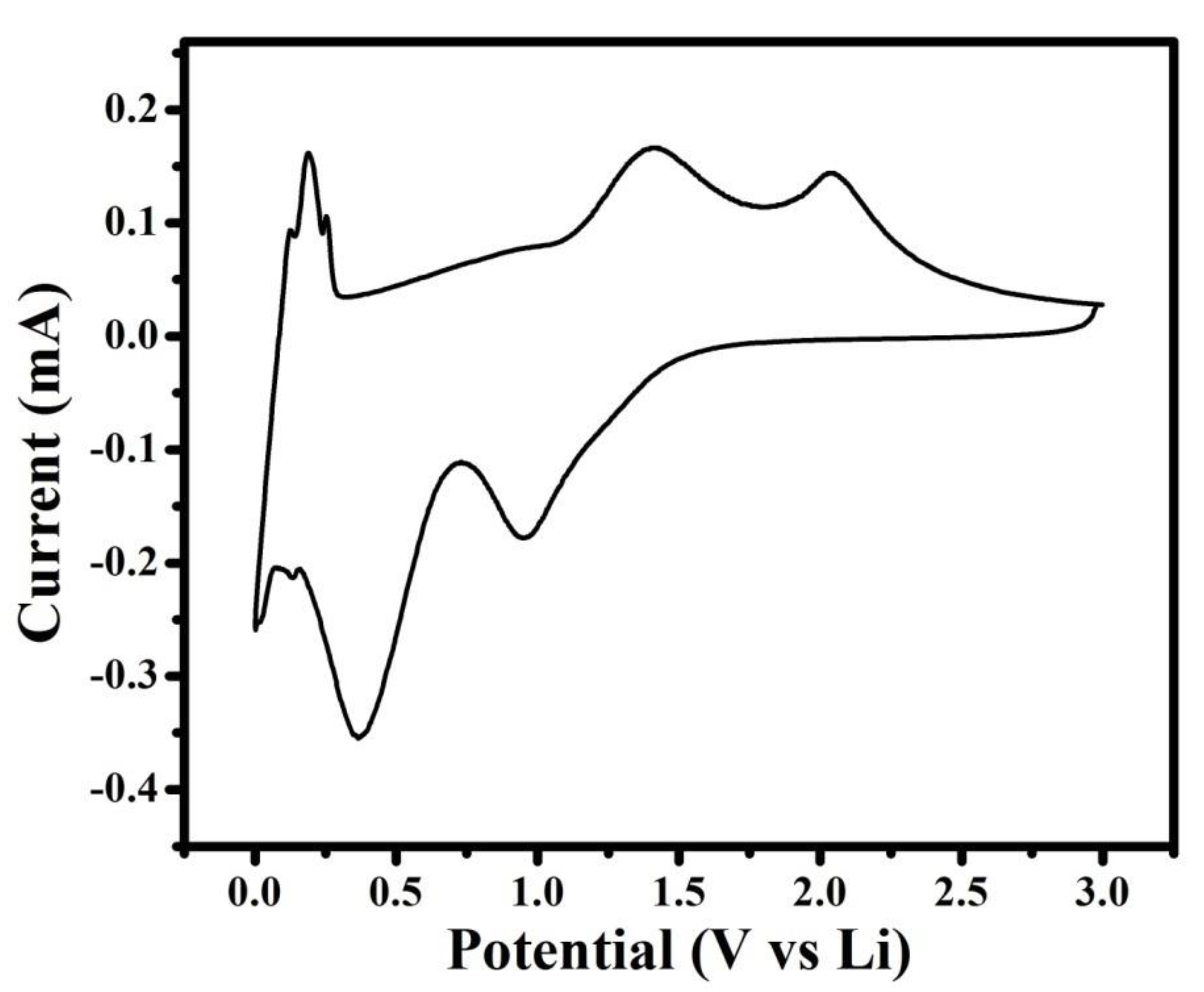



| Sr. No. | Material | Synthesizing Method | Specific Capacity (mA·h/g) | Current Density (A/g) | Reference |
|---|---|---|---|---|---|
| 1. | NiMn2O4 | Citric acid-based combustion method | 983 | 0.1 | Present work |
| 2. | NiMn2O4/rGO | Dipping process | 1535 | 0.1 | [22] |
| 3. | NiMn2O4 | Hydrothermal | 500 | 0.1 | [22] |
| 4. | NiMn2O4/C | Solvothermal | 1617 | 0.1 | [24] |
| 5. | Fe doped NiMn2O4 | Facile nanocasting method | 470 | 1 | [25] |
| 6. | NiMn2O4 | Hydrothermal | 1090 | 0.1 | [27] |
Publisher’s Note: MDPI stays neutral with regard to jurisdictional claims in published maps and institutional affiliations. |
© 2021 by the authors. Licensee MDPI, Basel, Switzerland. This article is an open access article distributed under the terms and conditions of the Creative Commons Attribution (CC BY) license (http://creativecommons.org/licenses/by/4.0/).
Share and Cite
Rajoba, S.J.; Kale, R.D.; Kulkarni, S.B.; Parale, V.G.; Patil, R.; Olin, H.; Park, H.-H.; Dhavale, R.P.; Phadatare, M. Synthesis and Electrochemical Performance of Mesoporous NiMn2O4 Nanoparticles as an Anode for Lithium-Ion Battery. J. Compos. Sci. 2021, 5, 69. https://doi.org/10.3390/jcs5030069
Rajoba SJ, Kale RD, Kulkarni SB, Parale VG, Patil R, Olin H, Park H-H, Dhavale RP, Phadatare M. Synthesis and Electrochemical Performance of Mesoporous NiMn2O4 Nanoparticles as an Anode for Lithium-Ion Battery. Journal of Composites Science. 2021; 5(3):69. https://doi.org/10.3390/jcs5030069
Chicago/Turabian StyleRajoba, Swapnil J., Rajendra D. Kale, Sachin B. Kulkarni, Vinayak G. Parale, Rohan Patil, Håkan Olin, Hyung-Ho Park, Rushikesh P. Dhavale, and Manisha Phadatare. 2021. "Synthesis and Electrochemical Performance of Mesoporous NiMn2O4 Nanoparticles as an Anode for Lithium-Ion Battery" Journal of Composites Science 5, no. 3: 69. https://doi.org/10.3390/jcs5030069








